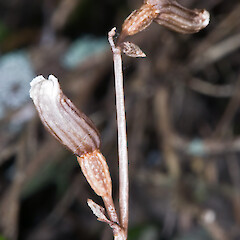Gastrodia minor
Common name
gastrodia
Synonyms
None
Family
Orchidaceae
Flora category
Vascular – Native
Endemic taxon
Yes
Endemic genus
No
Endemic family
No
Structural class
Orchids
Chromosome number
2n = 40
Current conservation status
The conservation status of all known New Zealand vascular plant taxa at the rank of species and below were reassessed in 2017 using the New Zealand Threat Classification System (NZTCS) – more information about this can be found on the NZTCS website. This report includes a statistical summary and brief notes on changes since 2012 and replaces all previous NZTCS lists for vascular plants.
Please note, threat classifications are often suggested by authors when publications fall between NZTCS assessment periods – an interim threat classification status has not been assessed by the NZTCS panel.
- Conservation status of New Zealand indigenous vascular plants, 2017 . 2018. Peter J. de Lange, Jeremy R. Rolfe, John W. Barkla, Shannel P. Courtney, Paul D. Champion, Leon R. Perrie, Sarah M. Beadel, Kerry A. Ford, Ilse Breitwieser, Ines Schönberger, Rowan Hindmarsh-Walls, Peter B. Heenan and Kate Ladley. Department of Conservation. Source: NZTCS and licensed by DOC for reuse under the Creative Commons Attribution 4.0 International licence.
2017 | Not Threatened
Previous conservation statuses
2012 | Not Threatened
2009 | Not Threatened
2004 | Not Threatened
Distribution
Endemic. New Zealand: North Island, South Island, Stewart Island/Rakiura, Chatham Islands.
Habitat
Lowland to montane (up to 1200 m a.s.l.). Usually in shrubland, often dominated by kahikatoa (Leptospermum scoparium J.R.Forst. et G.Forst.) or members of the kānuka (Kunzea spp.) genus. Also commonly seen within pine plantations and growing amongst Spanish heather (Erica lusitanica Ruldophi).
Detailed description
Terrestrial, saprophytic, deciduous, fleshy, perennial herb lacking chlorophyll. Plant at flowering up to 300 mm tall. Rhizome mycorrhizal, tuberous, rather swollen, short-lived, extensively branched, individual sections up to 40 × 10 mm, dull pale brown to brownish-black, sparsely clad in chartaceous scales, especially toward the active apex. Stem 1.5–2 mm diameter, dark brown to brown-black, slender, rather brittle when fresh. Scale leaves chartaceous, few, small and widely spaced. Flowers up to 10, brownish-black, usually cleistogamous, unscented, erect to spreading, tubular, sparsely tuberculate toward base, tubercules paler in colour. Perianth 6–10 × 2–4 mm, lobes slightly thickened toward margins. Lateral sepals fused slightly above the gibbous base otherwise with their margins lying close together. Labellum 2.5–4 × 1.0–2.0 mm, white, narrow-oblong, membranous, not irritable, completely enclosed within floral tube (apex just visible in the open flowers) and mostly fused to it, thickened distally, margins narrow, slightly undulose, bearing two long median, cristate, pinkish white calli, apex yellow. Column very short, wing a minute, erect, process; anther terminal, erect and bending forwards, short, ellipsoid, operculate, filament scarcely pleated at the back, pollen breaking into angular granules; stigma basal, immediately below anther, ellipsoid, hollow; rostellum flap-like, positioned under anther.
Manaaki Whenua Online Interactive Key
Similar taxa
Easily distinguished from the other New Zealand Gastrodia species by its much smaller size (up to 300 mm tall), and fewer flowered (< 10), much narrower, smaller, mostly blackish-brown, tubular flowers that scarcely open (if at all). The perianth lobes are internally white, and the labellum distinctly yellow-tipped.
Flowering
November–March
Flower colours
Black, Brown
Fruiting
January–April
Life cycle
Minute seeds are wind dispersed (Thorsen et al., 2009).
Propagation technique
A saprophytic species which should not be removed from the wild. Difficult to grow.
Etymology
gastrodia: Belly tooth (flower centre)
minor: Smaller
Where To Buy
Not commercially available
Attribution
Description adapted from Moore and Edgar (1970)
References and further reading
Moore LB, Edgar E. 1970. Flora of New Zealand, Volume II. Indigenous Tracheophyta: Monocotyledones except Gramineae. Government Printer, Wellington, NZ. 354 p.
Rolfe J. 2017. Guide to New Zealand Gastrodia (Orchidaceae) (pdf, 5Mb).
Thorsen MJ, Dickinson KJM, Seddon PJ. 2009. Seed dispersal systems in the New Zealand flora. Perspectives in Plant Ecology, Evolution and Systematics 11: 285–309. https://doi.org/10.1016/j.ppees.2009.06.001.












